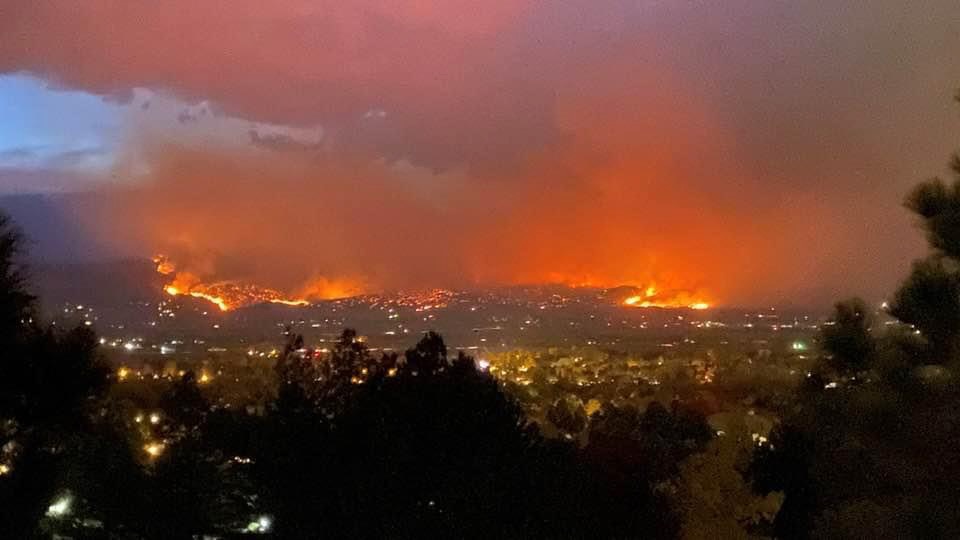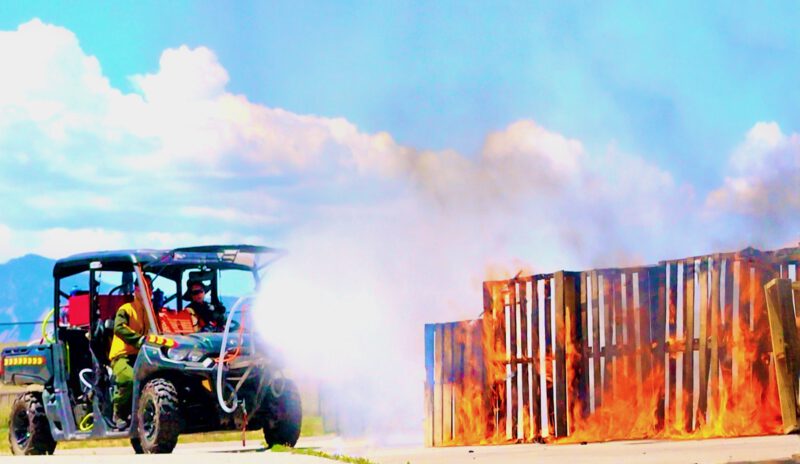Wildfires are fast becoming one of the world’s most detrimental ecological disasters. Climate change and the resulting lack of moisture in forested areas are contributing to the crises seen on the West Coast of the U.S., the heartland of Australia, and many other areas of the planet.
Movie special-effects coordinator Steve Wolf created Team Wildfire to tackle the challenge of putting out wildfires. After spending most of his life figuring out new and creative ways to blow things up, Wolf is turning his pyro-manipulation talents in innovative directions to combat this enormous threat.
“My dad got me a chemistry kit when I was eight,” said Wolf. “The whole purpose of chemistry, I thought at the time, was to blow stuff up. I combined that thrill with some advice my dad had given me, when he said, ‘Find what you like to do, then figure out how to make a living at it’ and used that passion to make a fascinating career in stunts and special effects.”
Wolf founded Team Wildfire, formerly known as PyroNemesis, in 2020, after years of working with the idea of manipulating fire with man made weather.
“I had worked with director Sydney Pollack on the Tom Cruise movie The Firm,” said Wolf. “In one scene there was a small leaf fire. And at the end of the shot, Sydney joked, ‘Steve, the fire looked great. You don’t have to put it out, but it can’t stay here,’” because they needed to put the camera where the fire had been.
“And that’s really what gave me the idea of moving fire fuels. Not just putting them out, but physically pushing them away, especially if adverse winds are blowing fire towards you. You need to blow it back, harder.”
That inspiration led to a decade-long endeavor of creating a functioning machine capable of providing intense counter winds, stripping away fuel, generating massive evaporative cooling, and depleting the oxygen that feeds wildfires.
The answer was a “hurricane on wheels.” Team Wildfire now has a working prototype, the StormCell. They are working on a mid-sized CloudBurst, and a huge version, the Hurricane, which can be AI-enabled and remote-controlled.
Like many visionary engineers, Wolf speaks almost exclusively in the present tense, describing in great detail the intricate workings of a technology that he’s largely yet to build. For him, seeing it clearly in his mind is the big work, and the physical fabrication is the easy part.
How Does the Tech Work?
Essentially, the system consists of jet engines mounted on highly capable off-road vehicles of different sizes, from a nimble UTV that can run up trails to attack a single tree lightning fire, to a huge logging forwarder that can attack large swaths of land in difficult terrain. Attached downstream of each engine is a mist injection chamber that adds various fire suppressants and retardants to the exhaust.
The jet engines can be used in several ways. They can clear land of flammables, perform direct attack, direct mists to fire to cool the fuels, physically remove burning limbs from trees using hurricane force winds, and drive backfires in the face of adverse winds. The system is designed to blow anything that’s burning back over the char zone, while simultaneously stripping away fuels in front of the fire by directing the jets downward. Of course this could also be used to penetrate fire swept areas and rescue trapped or injured firefighters.
The jets can be controlled independently, so the operator, or the Fire OS AI System, can use one engine for direct attack, another for ground clearing and another to create a rain umbrella that showers the fire from above, to capture, extinguish, and precipitate embers, so that ember cast can be reduced.
The suppression tech can be controlled from inside the cab, or by remote control, allowing the vehicle to be placed where it’s most effective, without having to compromise its position out of concern for an operator. Because of the amount of thrust involved, load sensors are used to keep the vehicle from flipping over. Traction and tip-over sensors are on every axle, so when the vehicle detects less traction or less weight on any axle, it can automatically rotate the engines up to counter that, and throttle them down.
In the fluid tanks, air bladders can be inflated from either side to shift the center of gravity of the vehicle to counteract jet recoil or the grade of the terrain.
The operator, either onboard or remotely, wears a mixed reality headset, connected to live video, LIDAR, and infrared feeds. The images are combined allowing the operator to see through the fire, view a model of the terrain that they’re driving over, and see the position and effect of the jets. The system can be used at night, and in any weather, so it can stay on station and active 24/7. In comparison, conventional fire fighting largely stops in the dark.
Another extremely important use of the technology that Wolf envisions is “evacuation route hardening,” wherein the machines are driven down defined evacuation routes monthly, using their jet engines to apply long term retardants deep into roadside trees and greenery, to make sure that when people need to use that route to escape, it’s not a fiery death trap of burning trees and blacktop.
Applications for Modern Firefighting
Operators can be swapped out, and mid-shift refueling allows the vehicle to suppress fire continuously.
Compared with some of the limitations of aerial firefighting, including that their dangerous chemicals can’t be dropped near lakes, streams, ponds or reservoirs, the Team Wildfire systems uses eco-friendly suppressants that can be used in sensitive environments. Chemicals currently in frequent use contain phosphorus and other ecologically unfriendly agents.

One of the principal sufferings caused by wildfires is damage to watersheds and municipal water supplies. Trees and root systems that form the vegetative barrier protection against mudslides are lost. As a result, when it rains after a major wildfire, mud cascades down into rivers and reservoirs and clogs them up. Team Wildfire’s ability to operate close to bodies of water, and maintain vegetative protection around them, is very important — and is an issue not well addressed by older tech.
Derivative of Wolf’s early interest in chemistry, Team Wildfire is committed to surfactants, suppressants, retardants, gelling agents and foaming agents that are based on natural, food-grade materials that can be safely applied to homes and vegetation, and is working closely with North American-based formulary NeroShield Fire. In fact, many of these formulations have the positive effect of improving soil’s ability to absorb and hold water. After a fire, that enhances soil’s ability to support revegetation.
To ensure that Team Wildfire tech would be well received by fire teams that are often resistant to change, Wolf partnered with Chief Andy Amalfitano, of the Boulder Emergency Squad, and Dan Eamon, a wildland fire chief and former public safety chief. Zach Jordan is the team’s lead engineer. Together, they are crafting their technology not only to put out fires with next level tech, but to integrate with current and emerging tech, tactics, and operations. Winter Winds Robotics is also contributing to the technology, bringing NASA grade robotics to the project.
Currently, fire suppression is a $3.5 billion-a-year expense in the United States, with similar figures in Canada and even larger numbers in Australia. That number continues to grow year over year, confirming forecasts that wildfire consumption and occurrence will more than double in the coming years.
Team Wildfire’s proof of concept was validated in the 90s when Hungarian engineers used 2 MiG-29 engines on a military tank as a fire suppression system that quickly blew out oil well fires in Kuwait. With the versatility and new approaches to firefighting that Wolf’s system offers, it is likely we will see Team Wildfire’s people and technology deployed on an enormous scale in the very near future.











